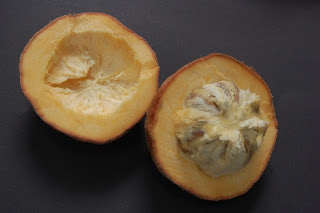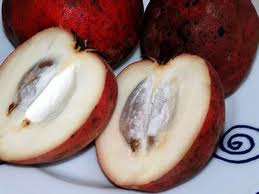Mabolo, also known as the
velvet apple, is related to persimmons and date plums. However, mabolo’s stench
and unusual flavor inhibits many from devouring this fruit with the same gusto
as its close cousins. In the Philippines, mabolos are endangered because people
value its hardy timber far more than the fruit itself. Indeed, mabolo wood is
the base of beautiful handicrafts and expensive combs. Ask about the fruit,
however, and one is met with an indifferent shrug.
Origin of Mabolo
Mabolo
originates in the Philippines, specifically from Luzon to the Sibu Islands off
of Malaysia’s eastern coast. Locals there know the fruit as buah mentega, and its Filipino name of
mabolo means “hairy” on account of its fine-fuzzed skin. Only a handful of
rural vendors sell the fruit. In Malaysia, one local described the fruit as
“nearly extinct.” To protect the endangered tree, Filipino authorities place
stringent regulations on the outflow of mabolo wood.
Today,
mabolos pepper the low altitude forests in Sri Lanka, Taiwan, Malaysia, Bangladesh,
Pakistan, Sumatra and Java. They are also hobby crops in Jamaica, Puerto Rico,
Trinidad, Honduras, and Cuba.
According
to the book, “Fruits of Warm Climates,” mabolos first appeared in Kolkata in
1881. Though not a popular tree, the fruit is a minor crop in India.
Availability of Mabolo in India
Velvet apples grow plentiful
in Assam and Bihar, and it’s also possible to find them on a limited scale in Kolkata
and the south of India. The fruits flower in March and April, then ripen from
June through September. Some varieties are available year-round.
Where to find Mabolo in India
Velvet apples are not
commercially grown in India, and are thus hard to find. The best bet of finding
the cream cheese-like fruit is on roadside stalls in Northeast India during the
summer months. A few trees also grow in Mumbai’s Jijamata Udyaan gardens.
Checking for Ripeness in Velvet
Apple
Velvet
apples are green on the tree and turn gold upon ripening. When ready to be
plucked from the tree, mabolos display a rust color or a deep crimson hue on
its powdery, velvety skin. Another giveaway of the fruit’s ripeness is its
musky, pungent smell. As is true of several fruits, the stronger the aroma, the
riper the fruit.
Taste of Velvet Apple
The fruit’s cheese-like
stench deters many from trying the fruit, but it’s worth trying a bite or two
of the white flesh if available. Mabolo pulp’s texture is sandy and creamy,
almost melting in the mouth. Its mealy consistency is similar to a pear’s, but
drier and not as juicy. Long-term residents living in growing regions rave
about mabolo’s mild taste, although first-time tasters seldom share the
enthusiasm.
In India, velvet apples
are two colors: light red, and crimson. The lighter cultivars tend to be
sweeter, but both are pleasantly edible. The taste has been likened to “fruit
cream cheese,” and a cross between bananas and apples.
Note: Sometimes the smell
causes people to perceive the taste as musky and oniony; however, mabolo’s
unpleasant smell is entirely because of compounds in the skin. If the smell is
too off-putting, peel the fruit and place it in the refrigerator. Doing so will
cause the aroma to dissipate after a few hours. The taste should subsequently
improve.
Nutritional Value of Velvet Apple
According
to a nutritional analysis published in the paper, “Variability and Performance
of Superior Velvet Apple Germ Plasm in the Hilly Region,” and a Purdue
horticulture article*, 100g of edible flesh contains the following:
113kcal
26.6g
Carb
1.5g
Fiber
.1g
Fat
58mg
Calcium
2.8g
Protein*
18mg
Phosphorous*
.6mg
Iron*
35IU
Vitamin A*
.02mg
Thiamine*
.03mg
Riboflavin*
.03mg
Niacin*
18mg
Vitamin C*
Health Benefits of Mabolo
Several
cultures use mabolo in traditional remedies. In Southeast Asia, velvet apple
juice treats diarrhea, dysentery, insect bites, cough, diabetes, and stomach
ailments. Bangladeshis utilize the leaves and bark to heal snakebites and to
cleanse the eyes; and in Guiana, locals consume the fruit to remedy
hypertension and heart problems. A tea of the bark and leaves are used to treat
skin issues as well.
Little
scientific research has been conducted on mabolo, but results are promising:
--According
to a study published in “Inflammation,”
scientists in Korea found that velvet apple extracts exhibited anti-inflammatory activities in the
airway passages of mice, thus supporting its traditional use in treating allergic bronchial asthma.
--A
study published in “Natural Product
Research” indicates that the leaves have potent analgesic qualities.
--A
2012 study published in the “International
Journal of Pharmacology” found that mabolo’s leaf extracts might be a
useful anti-diarrheal agent.
How to Open/Cut:
Though mabolo’s hairy
skin is edible, most peel the fruit and only consume its white-fleshed pulp.
Most velvet apple
varieties contain 4 to 5 large seeds that require removal. If the fruit’s shape
resembles an apple, it very likely has seeds. If the fruit is globose, it might
be one of the rare seedless cultivars.
To use in recipes, cut
the fruit into quarters and then into eights before removing the skin. Next, take a paring knife and cut the
flesh away from the heavily scented, velvety peel. Scoop away the seeds from some of the wedges,
and then place the slices into the refrigerator to lose the unpleasant smell.
Note: let the peeled
fruit cool in the refrigerator before mixing it with any other foods.
Otherwise, the ingredients will take on mabolo’s smell.
Storage:
Place at room
temperature, where the fruits should keep up to one week.
Mabolo Recipe Ideas and Uses:
--Peel and slice mabolo
into thin segments and sauté with
oil, salt and pepper, just like a vegetable. Add as part of a stir-fry or consume as-is.
--Peel mabolo and blend
fruit chunks with coconut milk and banana for a tropical smoothie
--Add cubes of the fruit
to a salad, particularly one that
includes apple, pears and bananas.
--Make velvet apple butter by adding 1 cup of
sugar for every 6 cups of fruit. Peel and chop the fruit, and then simmer in
water limejuice. Remove from the heat when soft, and blend the fruit with
sugar.
Note: when dry heated,
the fruit becomes tougher and fibrous—these qualities are attractive if
preparing savory stews and roasts, but may not be as desirable for use in sweet
breads and creamy desserts.
Flavor Complements:
Apple, pear, banana,
sapota, persimmon, apricot, Asian pear, breadfruit, guava, citron, coconut,
custard apple, date, jujube, melon, peach, pineapple, pomegranate, sapota,
santol
Herbs, spices, and oil: Sugar, salt, lime, lemon, brown sugary/jaggery,
cinnamon, nutmeg, star anise, rum, coconut milk, salt, pepper, chili
Scientific Name:
Diospyros blancoi
Diospyros discolor (wild)
Other Names:
Seralat
Sagalet
Buah
Mentega
Peach bloom















dear madam
ReplyDeletewe are trying to grow the plant . we trying to propagate the plant by air layering ,we failed several times , if you had seeds plz send us , or any nurseries address which grows , plz massage me at muralikamana @ face book
Hi? Anybody tried in South India? Iam from Bangaluru & interested more on this fruit.
ReplyDeleteThis tree is in our house.very sweet fruit.in bengali its name is 'GAB'.it has a smell.i love it.
ReplyDeleteHow do you know when the fruit is ripe or need to be plucked from the tree. Lastly, when the tree is bearing fruits, can you water the tree?
ReplyDeleteIt turns a rust/otangeish color when ripe. Im in Hawaii, we go to the state parks to pick them when ready.
DeleteIf u want seed or plant.. Please contact me.. From wB
ReplyDeleteI have found that this site is very informative, interesting and very well written. keep up the nice high quality writing Omega 3
ReplyDelete